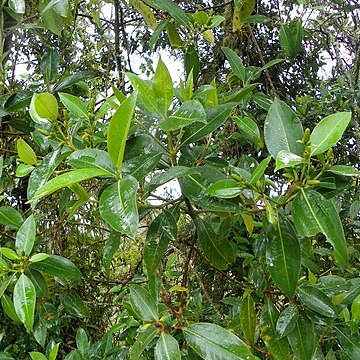Monoecious or dioecious aromatic shrubs or trees, rarely herbs, often with prop roots; wood white, usually soft; stems with persistent leaf sheaths or with encircling leaf sheath scars; nodes swollen. Leaves fleshy to coriaceous when fresh; margins dentate; petioles with expanded bases forming a connate sheath around stem; distal margin of leaf sheath with or without stipular appendages. Staminate inflorescences composed of a solitary spike or with several spikes on a racemose or paniculate axis, subtended by a pair of leafy bracts; spikes with 50-300 flowers. Staminate flowers consisting of a solitary, sessile, ebracteate stamen; stamens quadrangular to oblong, 4-locular, longitudinally dehiscent, anther connective extended with apex, flat, acute or acuminate. Pistillate inflorescences solitary, thryse-like, racemose, or paniculate, subtended by leafy bracts; flowers solitary or more often clustered into cymules. Pistillate flowers consisting of an ellipsoidal or trigonous ovary, with perianth adnate to ovary with 3 free or partially fused lobes at apex of ovary, subtended by a chartaceous or fleshy floral bract that often encloses flower. Fruit a drupe with a fleshy wall formed by fused perianth or multiple with connate floral bracts becoming fleshy and colored (white or purple); seeds small, brown or black, ellipsoidal or trigonous, smooth or minutely papillate.
Monoecious or dioecious aromatic shrubs or trees, rarely herbs, often with prop roots; wood white, usually soft; stems with persistent leaf sheaths or with encircling leaf sheath scars; nodes swollen. Leaves fleshy to coriaceous when fresh; margins dentate; petioles with expanded bases forming a connate sheath around stem; distal margin of leaf sheath with or without stipular appendages. Staminate inflorescences composed of a solitary spike or with several spikes on a racemose or paniculate axis, subtended by a pair of leafy bracts; spikes with 50-300 flowers. Staminate flowers consisting of a solitary, sessile, ebracteate stamen; stamens quadrangular to oblong, 4-locular, longitudinally dehiscent, anther connective extended with apex, flat, acute or acuminate. Pistillate inflorescences solitary, thryse-like, racemose, or paniculate, subtended by leafy bracts; flowers solitary or more often clustered into cymules. Pistillate flowers consisting of an ellipsoidal or trigonous ovary, with perianth adnate to ovary with 3 free or partially fused lobes at apex of ovary, subtended by a chartaceous or fleshy floral bract that often encloses flower. Fruit a drupe with a fleshy wall formed by fused perianth or multiple with connate floral bracts becoming fleshy and colored (white or purple); seeds small, brown or black, ellipsoidal or trigonous, smooth or minutely papillate.
Dioecious or monoecious aromatic shrubs or small trees. Leaves opposite, generally elliptic to lanceolate, pinnately veined, margin serrate, the petioles connate into a pronounced petiolar sheath enclosing first the apical bud and later the stem, stipules setose to fimbriate. One or two superposed axillary buds may develop from each leaf axil, these buds sometimes becoming exserted from the petiolar sheath by elongation in the nodal region. When the inflorescence is monoecious the terminal bud and the first pair of subtending axillary branches often bear pistillate flowers, while the second and subsequent pairs bear staminate flowers. Staminate catkin of 1 to several cylindrical spikes which greatly elongate at anthesis; flowers naked, ebracteate, sessile or subsessile, each composed of a single bilocular stamen, the connective variously produced, the anthers longi-tudinally dehiscent. Pistillate inflorescence racemiform, paniculiform or spiciform; flowers monochlamydeous, bracteate, perianth fused into a tri-lobed urceolate cup persistent in fruit; ovary unilocular, uniovulate; style short, deciduous; fruit a small three-angled drupe.
Trees or erect subshrubs, monoecious or dioecious; branches jointed. Leaves opposite, usually serrate; petiole connate, forming a sheath at base. Inflorescences axillary or subterminal. Flowers unisexual, fragrant. Male flowers clustered in spikes; stamen 1; filaments nearly absent; anther 2-loculed, linear or oblong, transversely arranged; connective with a short appendage at apex. Female flowers in various capitula or panicles; tube of perianth 3-toothed, calyxlike, adnate to ovary; style very short or absent. Drupes globose or ovoid, sometimes trigonous, small; exocarp thin, fleshy; endocarp usually hard.

